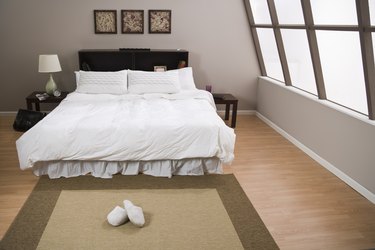
Much as it may be tempting to spread a floor covering you love over as many rooms as possible, every room has special needs when it comes to surfacing. The rooms on your upper floors present particular flooring challenges in terms of noise and moisture as well as specialized usage. Fortunately, the wealth of floor coverings available lets you choose the perfect covering for bedrooms, baths and other upstairs rooms.
The Noise Challenge
Video of the Day
Upper-story floor coverings need to address issues of noise, which can disrupt the peace of the most tranquilly decorated living room, dining room or downstairs bedroom. Hallway traffic is a frequent source of noise, and hall floors should be treated like room floors. Carpets, carpet padding and underlays for hardwood floors therefore carry industry-generated ratings of their ability to absorb noise. Materials may display IIC (impact insulation class) scores; the higher the number, the higher the material's noise-absorbing capacity. INR scores (impact noise reduction) were developed by the U.S. Department of Housing and Urban Development for multifamily dwellings. Often an INR score can be reconciled with a IIC score by adding 51. Acoustic ratings may also include a NRC (noise reduction coefficient), based on material absorption of a low-to-high range of sounds at 250, 500, 1,000 and 2,000 Hz. In broad terms, the thicker the layers of insulating floor coverings between upper and lower floors, the lower the noise transmission, but flooring professionals can help you interpret information to make the best choice for your specific location.
Video of the Day
The Master Bedroom
A master bedroom benefits from floor covering that is lush and soothing. Soft, dense-pile, wall-to-wall carpet in sumptuous wool is a logical choice for this restful retreat. High-quality nylon has a high resilience similar to that of wool. Adding 40-pound felt padding to wool or nylon carpet can reduce noise by 50 to 70 percent. The master bedroom is also a good place to install hardwood or hardwood laminate flooring. Underlays address specific creaks and clicks associated with wood flooring while reducing overall noise by 40 percent or more.
Children's Rooms
Easy care is the watchword for floor coverings in children's rooms. Low-pile carpets in durable polypropylene, nylon and other synthetics offer a range of colors from soft to intense. Because children's interests and color preferences change quickly, a large area rug laid over wood laminate, sheet vinyl or vinyl tile may provide more decor flexibility than wall-to-wall carpet. Laminated and hard-surface vinyl coverings make cleaning easy, and an assortment of machine-washable area rugs can provide easy-to-maintain draft-free play areas.
Bathrooms
A master bath may look far more elegant than the children's bathroom, but the water on both floors is just as wet. The first and critical flooring choice for bathrooms, especially on an upper floor, is water-impermeable. While this used to limit bathroom choices to varieties of porcelain tile, bathroom pavers now include marble and marble substitutes, stone and ceramic compounds. Vinyl sheet flooring imitates stone and tile surfaces. Laminates and hardwood flooring for bathrooms increasingly use adhesives to combat moisture retention or possible leaks. For the best bathroom flooring results, seek professional opinions on retaining or replacing existing sub-flooring. Especially in houses built before 1950, what appears to be linoleum tile may contain asbestos, which requires professional abatement. In some old houses, all subfloors may need careful inspection before you cover or remove them.
Home Office or Other Multipurpose Room
Floorings for multi-use upper-floor rooms work best if they are easy to maintain. Different floor coverings can distinguish work and relaxation areas. Tightly woven low-pile carpet in a neutral color sets a businesslike tone for a desk and chair, while a softer-textured area rug under the sleep-sofa clarifies the guest-room space. Let a large area rug do double duty by choosing a pattern quiet enough to accommodate office furniture. Coordinate guest bed linens, pillows and accessories with the rug to accentuate the room's hospitable function. In a craft- or hobby room, easily swept sheet vinyl makes it easy to retrieve pins, needles and tiny craft items while carpeting the other half of the room creates a cozy area for reading and listening to music.